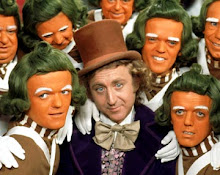11. Shuffle: On New Music
"The role of the forger", Gould wrote, "of the unknown maker of unauthenticated goods, is emblematic of electronic culture. A forger is also, if you look at the history of the word, a maker of links, one who works at the forge with fire, hammer, and steel, a welder of parts."
There’s been a recent obsession with “discovering” media through social networks and educated guesses based on statistics of what other users with similar tastes find interesting. Pandora radio is the most advanced musical version of this type of system. They’ve gone past pure statistics, actually doing research on what musical characteristics determine taste and enjoyment. This is called the Music Genome Project. Like most people my age, I consider myself somewhat of a music snob, but as with Netflix predictions of what movies I will like, it’s usually the formula that laughs last as Pandora makes a perfect selection of an obscure song that I’m obsessed with, or it plays a song that I’ve never heard before but like so much that I go out and buy it on iTunes [read torrent it for free]. Soon, these two services (iTunes + Pandora) will be combined, so that you could say, "all right, I feel like discovering new music, but not entirely, so make me a mix based off of this song, and give me a two-thirds mix of similar songs that I know/own versus songs that I haven't heard yet." This is like the passive learning we talked about above, only here it’s the passive discovery of new music.
We also spoke about ambient noise being mixed into the music, which is a progression of the modern obsession with multitasking. How often have you wished that you could listen to music in the background of a boring lecture or conversation? We see two friends on the train talking, each with headphones coming out of one ear. That’s like a 50/50 attention allocation, and it’s the future. The device’s microphone would have noise canceling so that you could tell to filter 80% of the outside noises of the street, but leave 20%. You can already see this trend as single ear bluetooths are now able to play music.
So what’s new? Say that the device was playing music softly in the background of a conversation. It’s also following along. As the subject turns to your mutual friend Tom, it slowly fades into the leitmotiv you already have set for him, thus channeling a subconscious memory of his character. It might also display a transparent ghost image of his face on your display- the constant multitasking of the senses.
This advanced computer DJ also reacts to outside environmental and temporal events. During the rain, or on a gloomy day, it might play appropriately subdued music. Right before an election, or a sports game, it might turn the mood to upbeat tracks with appropriate lyrics- remember, it has started to understand key words and subjects. Imagine watching the first rays of the sunrise perfectly timed to the climax of Also Sprach Zarathustra. Or location based music: you step on to the Brooklyn Bridge and it starts playing New York, New York by Sinatra. Again, this is the cinematizing of real life.
But there’s a new trend in music which similarly points toward this individual tailored sonic experience. Glen Gould, one of the greatest musicians and thinkers of the 20th century saw it coming long ago:
“Electronic transmission has already inspired a new concept of multiple authorship responsibility in which the specific functions of the composer, the performer, and indeed the consumer overlap.”
But Gould also had something to say for the autonomy of the listener. We are already given some freedom in how we listen to a recording through equalization- the adjustment of treble and bass levels on a car stereo- which changes the color or feel of a recording. Expanding on this, Gould realized that there would come a time when the listener would have even greater control. He talked about the ability to take and choose between, say, each of a dozen or so “perfect” takes of a particular piece- each recorded by the same performer, but having distinct feelings which make them individual. Certain dynamics would be emphasized or left out of particular passages, etc. Thus the listener would get to decide which recording was the most effective, or even splice two together to achieve a pleasing synthesis.
Working in the time of LPs, Gould was never able to see his vision in action, but today it is possible and in increasing demand. Throughout the past decade we have seen the popularization of audio “mashups” or synthesizes of multiple songs into one completely new product. This is basically a variation of a remix. At the same time, progressive artists have actually begun releasing the individual source tracks to their songs- enabling the easy extraction of audio, guitar, bass, drums, etc.- to allow for other artists to sample their work. This is the phenomena of remediation, which is a growing trend, and a progression of copy & paste aesthetic first seen in the pop art collages of the 1960’s. I talk about this much more here.
“The serious artist is the only person able to encounter technology with impunity, just because he is an expert aware of the changes in sense perception.” -McLuhan
The listener is the artist, and the art is selection.
The technical side of how these songs would be automatically woven together without sounding horrible is very complicated, but many people have developed different ways of getting it done, and the results are fascinating:
Track 2 is a remix that I made in less than 15 minutes, combining the beat of Hip Hop by Dead Prez, the lyrics of Lil' Wayne's Amile, and a keyboard invention by Johann Sebastian Bach, performed appropriately enough by Mr.Gould.

No comments:
Post a Comment